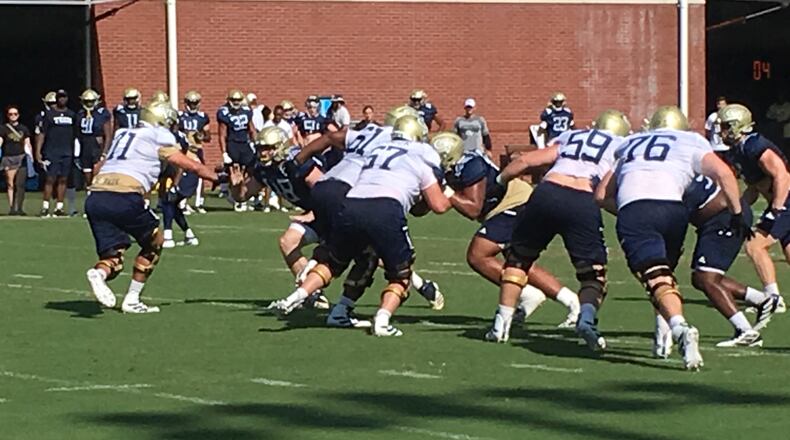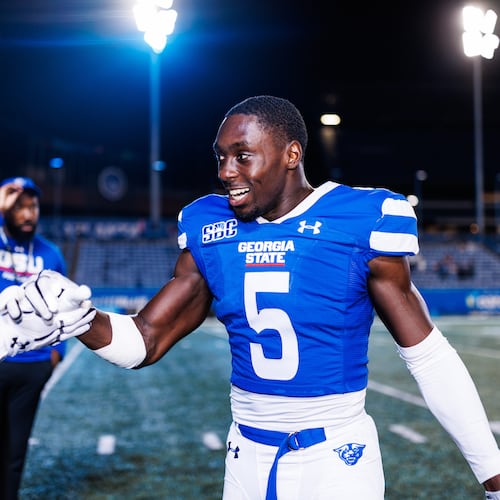Georgia Tech’s offensive line might be the group with the most uncertainty heading into the season.
To wit: If the season were to start Saturday, Georgia Tech’s starting five on the offensive line might include a guard who played in two games last season (Mikey Minihan), a grad transfer at another guard spot (Jared Southers), an offensive tackle who was a backup (Jack DeFoor), another offensive tackle who is adjusting to a body 30 pounds heavier than last year (Zach Quinney) and a walk-on at center (William Lay). And don’t forget that four of the five came to Tech to play in former coach Paul Johnson’s option offense, not offensive coordinator Dave Patenaude’s spread.
There’s plenty of time for the five-man group to rearrange, particularly as the line deals with injuries. Still, offensive-line coach Brent Key has a sizable task on his hands in developing a competitive line.
“There’s no excuses in our room, no excuses in our group,” Key said Friday. “And as their coach, there’s no way I would allow that to happen.”
Key continues to mix up combinations, but the fivesome (left tackle to right tackle) of Quinney, Minihan, Lay, Southers and DeFoor has worked together a good bit with the “A” offense. Tech is waiting for Kenny Cooper, who worked at left guard with the A offense in the spring, to return from an injury suffered early in the preseason.
“I don’t really consider any of the spots settled,” Key said. “We go out every day and continue to work different people at different spots. But at the same time, you’re going to be elevated above the line with the effort and intensity that you play with, and the entire culture here is built on effort.”
Lay is an intriguing possibility at center. A sophomore from Hart County in northeast Georgia, Lay has shown improvement in the preseason as he competes at center with fellow walk-on Chet Lagod, a junior from the Marist School. Neither Lay nor Lagod have played in a game for Tech. Key said that both have been doing a good job. Minihan, who has been working at left guard, is also a possibility at center.
“Will’s a very smart kid,” said Southers, who has earned a leadership role on the line since arriving as a grad transfer from Vanderbilt in January. “He works very hard. He had a great spring, he had a great summer. He’s just been playing as hard as he can and he’s doing some great things for us.”
Tech is in a position of potentially relying upon walk-ons in part because the Jackets have 13 scholarship offensive linemen, an atypically low number. Among key losses are Jahaziel Lee, who has moved to the defensive line (although he could conceivably play on both lines) and Parker Braun, the two-time All-ACC guard who left as a grad transfer for Texas. Further, Tech did not sign any offensive linemen to the 2019 class, although freshman defensive tackle Jamal Camp has shifted over to play guard.
Key likes the improvement that he has seen. Quinney, he said, has “really matured” and has benefited from adding about 30 pounds. Quinney, who started last year at left tackle as a redshirt freshman, is listed at 6-foot-6 and 295 pounds. (Quinney’s secret, besides strength coaches Lewis Caralla and Kyle Seger: eating ice cream every night.)
“I’m not going to lie; I feel (the weight) sometimes, but I feel it in the best way for the most part,” Quinney said. “I feel like it’s way easier to move people. Last year, if I had somebody 300 pounds in front of me, I really didn’t stand a chance to drive him off the ball.”
But, will that improvement carry the Jackets far enough to open running lanes and form clean pockets when the season starts? Key, taking a cue from his old boss (Alabama coach Nick Saban), passed on a question about his confidence that his unit will be ready to compete.
“I can’t answer a hypothetical question,” Key said. “You can’t answer questions that don’t have true answers to them.”
Key did add that if the group continues to improve every day, “they’re going to be in position to be a competitive group come the first game.”
It bears mention that, in Key, Tech does have one of the higher-paid offensive line coaches in the country ($600,000 annually), and players have responded.
“He really looks at the little things that a lot of O-line coaches overlook,” Southers said. “And another big thing with him is he pushes the heck out of us every single day. He’s on us, making sure that we’re playing as hard as we can and he’s trying to make us the best that we can be.”
Thus far in the preseason, there have been times in 11-on-11 work when the offensive line has helped the Jackets offense move the ball effectively and keep pressure off Tech’s quarterbacks. But that’s not been constant.
Hypothetically speaking, there’s still time for the group to develop.
“We all have pretty high confidence,” Quinney said. “In spring, it was very, very new to us like y’all know, but now a lot of film work all summer, a lot of extra work in the indoor (practice facility) all summer, we came out (improved). And now I feel like, as a group, we know what we’re doing for the most part. It’s time to execute.”
About the Author
Keep Reading
The Latest
Featured


